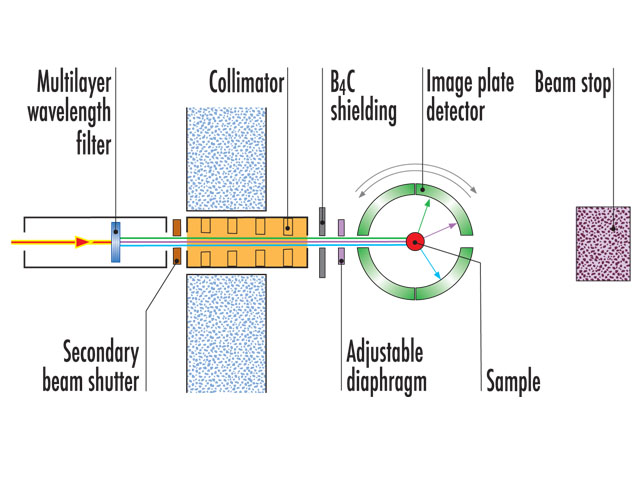LADI-III
Quasi-Laue diffractometer
LADI-III - A quasi-Laue diffractometer for macromolecular crystallography
The quasi-Laue diffractometer LADI-III (since 1995 as LADI and 2007 as LADI-III) is used for single crystal neutron studies at high resolution (2.5 – 1.5 Å) of biological macromolecules, such as proteins or nucleic acids, providing unique information that is complementary to X-ray crystallography. Locating the positions of hydrogen/deuterium (H/D) atoms and protons/deuterons (H+/D+) in a macromolecule, provides us with knowledge of the protonation states of key amino-acid residues, ligands or inhibitors, and the orientation of bound water molecules. These details allow a more complete understanding of a macromolecule’s specific function and behaviour.
Due to the low flux of even the most intense neutron sources, neutron macromolecular crystallography has historically been an intensity limited technique, requiring very large crystal volumes and long acquisition times. However, over the years, LADI-III has gone through a number of upgrades that have dramatically reduced both the crystal volumes required and the data collection times. This has placed LADI-III's performance in a world-leading position, despite the more recent appearance of instruments at other neutron facilities, such as BioDiff at FRM-II, MaNDi at SNS and iBIX at J-Parc. The smallest crystals used, largest systems studied and fastest data collections have all been achieved using LADI-III. Currently, LADI-III utilizes a multilayer bandpass filter for wavelength selection. The replacement of the multilayer bandpass filter with a neutron velocity selector is a planned future upgrade for LADI-III that will increase the neutron transmission by a factor of 2-3 and will allow more flexibility (in terms of wavelength bandwidth choice) so as to further optimize data collection strategies.
Applications
Neutron macromolecular crystallography projects typically aim to address questions concerning:
- Enzyme mechanisms
- Small-molecule (e.g. drug, ligand) binding interactions
- Rational drug-design
Instrument layout
LADI-III uses a large cylindrical area detector composed of neutron-sensitive image-plates, which completely surround the crystal and allows large numbers of reflections to be recorded simultaneously. Data are collected using quasi-Laue methods in order to provide a rapid survey of reciprocal space, while reducing the background on the detector compared to use of the full white beam.

